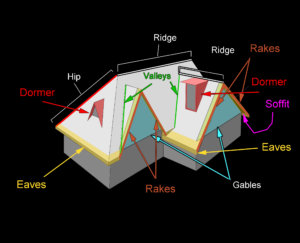If you are new to roofing and suddenly need some repair work, then the learning curve can be quite high. For example, searching through your local roofing companies blog will likely include lots of terms that sound confusing. What in the world is flashing? How am I supposed to know what underlayment does? What exactly does attic ventilation really do for me? These are all questions that we get often during our sales calls. To help, we are going to break down the different parts of your roof for you to allow you to better understand this key part of your home. Owens Corning is a key roofing supplier and discusses this ad nauseam. The following roofing anatomy relates to how installation of Owens Corning branded products. However, it is a fantastic primer for all things roof anatomy.
KDS444, CC BY-SA 3.0 <https://creativecommons.org/licenses/by-sa/3.0>, via Wikimedia Common
Main Pieces of Roof Anatomy
Roof Ridge – This is the highest part of the roof, where all pieces meet. This area requires special shingles that allow water and debris to shed down all sides of your roof. Similarly, this is the area for a ridge vent. These vents allow hot, stagnant air to release upward out of your attic. Much like all roof ventilation aspects, the ridge vent moves old air out of the attic space thus preventing mold growth from humid air. This allows for better home efficiency as well.
Hip – Much like the roof ridge, the hip is the area where two sloping roof planes meet. The shape is similar to that of the ridge, opposite of the aptly named valley. Roof hips also need special shingles much like the ridge shingle to ensure proper weather shed.
Valley – The valley is essentially the opposite of a hip. Much like the name suggest, this is where to descending slopes intersect and create a V shape. Valleys can either be flashed or shingled, depending on the area of the roof.
These are the three terms you will hear most often when describing the shape of a roof.
Water Shed Terms
Flashing – Flashing is often easy to see, as it is the metal material you will see scattered throughout your roof. Flashing is designed to shed water away from openings and intersections such as skylights and windows.
Drip Edge – This is a type of flashing that is installed on the edge of your roof to ensure water drips down rather than seeping under the shingle and onto the underlayment.
Underlayment – Underlayment is the undisputed champ in ensuring your roofing system stays watertight. This is a membrane system that is laid on the roof deck, or wooden structural foundation of your roof. This membrane is watertight and prevents water from getting under shingles and into your attic
Architectural Terms
Roof Gable – Also known as a rake, this is the triangular area that raises out of a roof often on the ends or middles of a roof. We often see multi-gabled homes in the older areas we service such as Cambridge.
Dormer – Similar to a gable, a dormer is the raised section of a roof for added space or windows.
The last terms we use are eaves and under eave vents or soffits. These are the areas underneath a roof where it meets the home. Lower, colder air is pulled in through these vents before being exhausted through the top of the roof.
We hope that these terms are useful in understanding your roof and its overall health. We are always blown away at the protection offered from the Owens Corning Total Protection Roofing System and every piece of the roof in encompasses. For more information or to schedule a free estimate, contact us today!

